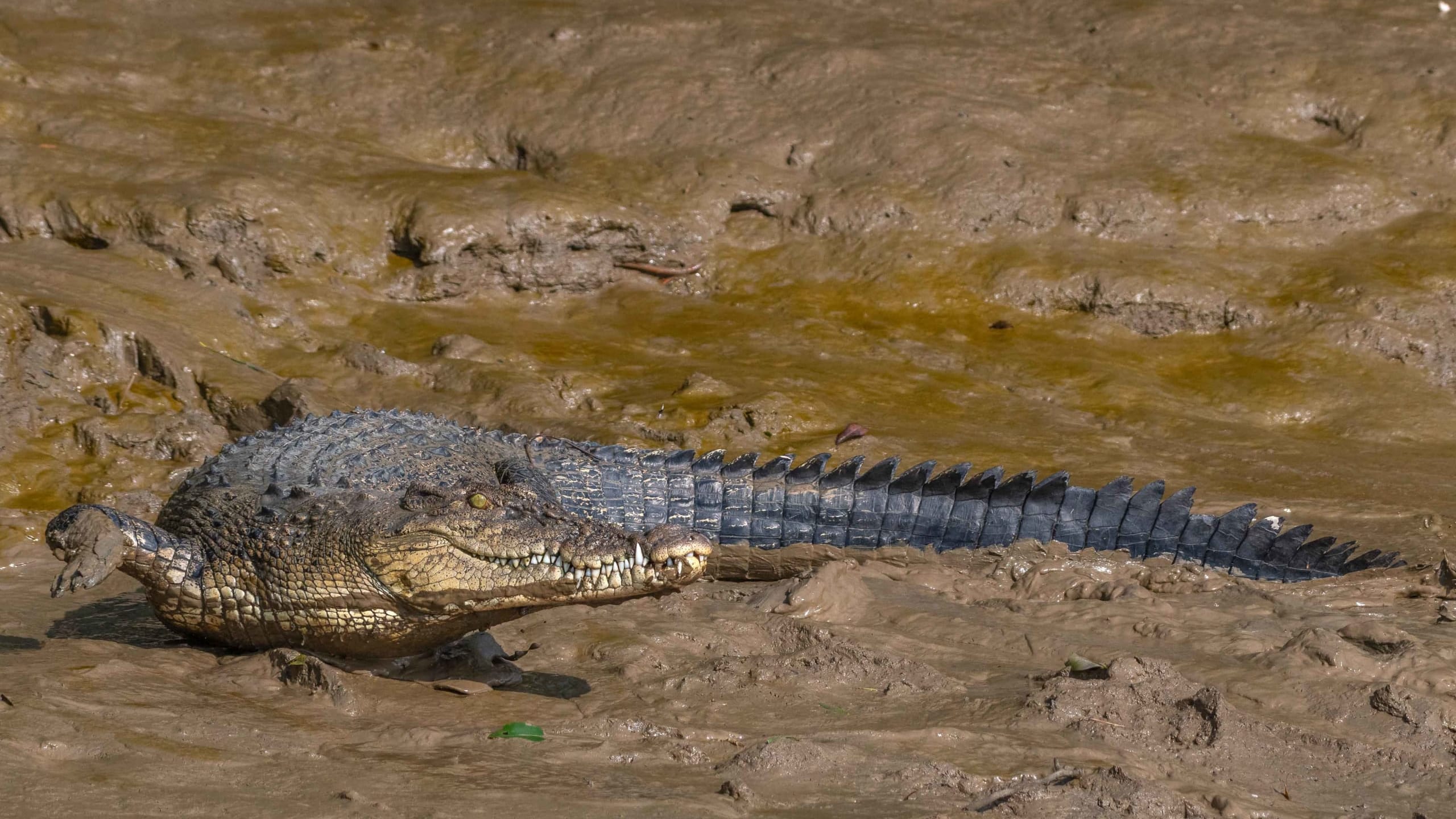 Listen to this article
•
15:34 min
Listen to this article
•
15:34 min
When the tide withdraws and reveals the sun-glazed riverbanks in Bhitarkanika’s mangrove forest, saltwater crocodiles (Crocodylus porosus) emerge onto the muddy shores for their daily dose of sunshine. Like all cold-blooded reptiles, crocodiles need to regulate their body temperature with ample basking, and the riverbank is prime real estate for this until it is submerged once again at high tide. As the apex predator in this wilderness, the hulking creatures don’t bother with camouflage. From a motorboat, we spot dozens of them from afar, all scales, teeth, and sinuous muscle.
Saltwater crocodiles are the largest reptiles in the world. As we cruise along the creeks, my guide Bijay Das points out an 18-foot-long specimen dominating the riverbank. Adult males can weigh up to 1,000 kg. Over the years, some of the most colossal specimens have been recorded in Bhitarkanika, including a 23-foot-long male considered the largest in the world. Most visitors to the national park make a pit stop at the Dangmal Visitor’s Centre where a massive 20-foot-long saltwater crocodile skeleton is ensconced in a glass case.

Cover Photo: On average, adult male saltwater crocodiles measure five to six metres in length. However, a handful of particularly large individuals that are more than seven metres long can be spotted in Bhitarkanika. Cover Photo: Aditya Panda
Bhitarkanika has gained a reputation for its abundance of exceptionally large crocodiles, but Odisha-based wildlife expedition leader and conservationist Aditya Panda notes that 20-foot-long specimens are more the exception than the rule. “Unlike most warm-blooded animals, reptiles grow all their lives”, he says. “The average size of saltwater crocodiles in Bhitarkanika is similar to other populations, say, for example, in Australia. In Bhitarkanika, the saltwater crocodile has received strict protection for many years. This has led to the survival of many large individuals that perhaps exist less in other populations, because most large individuals have been lost to poaching.”
Bhitarkanika was the former hunting ground of the Kanika kings. Crocodiles were extensively hunted here and the mangrove forests they inhabited unduly exploited. Hunting, habitat loss, and predation of their young drove saltwater crocodile numbers down, until there were only around 95 individuals left in Bhitarkanika in the mid-1970s.
In 1975, a government-run crocodile conservation project was implemented in Odisha in collaboration with the UNDP and the FAO. A hatchery was established at Dangmal, and the project adopted a “rear and release” approach. Crocodile eggs were collected from the wild and the young were reared away from predators. On reaching a suitable size, they were released into protected areas. The Wildlife Protection Act in 1972 and the subsequent notification of Bhitarkanika to a wildlife sanctuary in 1975 put an end to hunting.
The crocodiles assimilated into their natural habitat, and their numbers grew significantly. Today, around 70 per cent of India’s saltwater crocodile population is found in Bhitarkanika. As per the January 2022 census, the region is home to a healthy population of 1784 individuals.
Over the course of three days, I spot dozens of crocodiles daily, occupying the riverbanks or gliding noiselessly across the water. It is impossible to imagine the landscape without these icons of the mangroves.
In stark contrast to the massive, stoic adults are the palm-sized baby crocs and foot-long yearlings were slipping along the muddy banks, leaving skid marks in their wake. It is December and a new crop of hatchlings emerged around three months ago. At this stage of their lives, they are at their most vulnerable, falling prey to large fish, monitor lizards and even raptors who scoop them up in their strong talons. Overhead, we spot a white-bellied sea eagle.
Later, on a walking trail in the Bhitarkanika Forest Block, we get a close look at the habitat that offers saltwater crocodiles a safe haven. As we traverse narrow paths lined with mud pools and aerial roots, Das points out various species of mangrove foliage, like the bani, sundari, and most notably, the plentiful hental or Phoenix paludosa. Female crocodiles use the large palm leaves of the plant along with twigs and mud to build mound nests. In a landscape that is entirely submerged by the tide twice a day, finding a nesting spot can be tricky. The riverbank is out of bounds, and a female crocodile must go in search of higher ground deep within the mangrove forest. "Their instincts guide them to places where tidal water is less so their eggs don’t get submerged," says Das.
Females of the species mature at around 15 years, and lay around 40-60 eggs per season, which hatch after 80-90 days of incubation. Approximately half the eggs hatch, and even fewer make it to adulthood. “Only about one in 500 hatchlings survives predation and other natural causes of death to reach adulthood”, says Panda.
Even as the apex predator, the lives of crocodiles are not without threats in the wild. Panda explains: “Saltwater crocodiles are among the most aggressive of all crocodilians and highly territorial. Cannibalism is occasionally observed, fights are frequent and it is not unusual to see individuals with missing limbs and many scars.”
In the face of such odds, Bhitarkanika’s conservation of the saltwater crocodile is remarkable. But as human pressure on the mangrove habitat increases, efforts to sustain a healthy population of the flagship species, and all the other inhabitants of this forest, must continue.
Panda sums it up: “The future of the saltwater crocodile depends on the future of our coasts and coastal ecosystems. Climate change and human activity continue to make these among the most vulnerable of all our ecosystems.”













